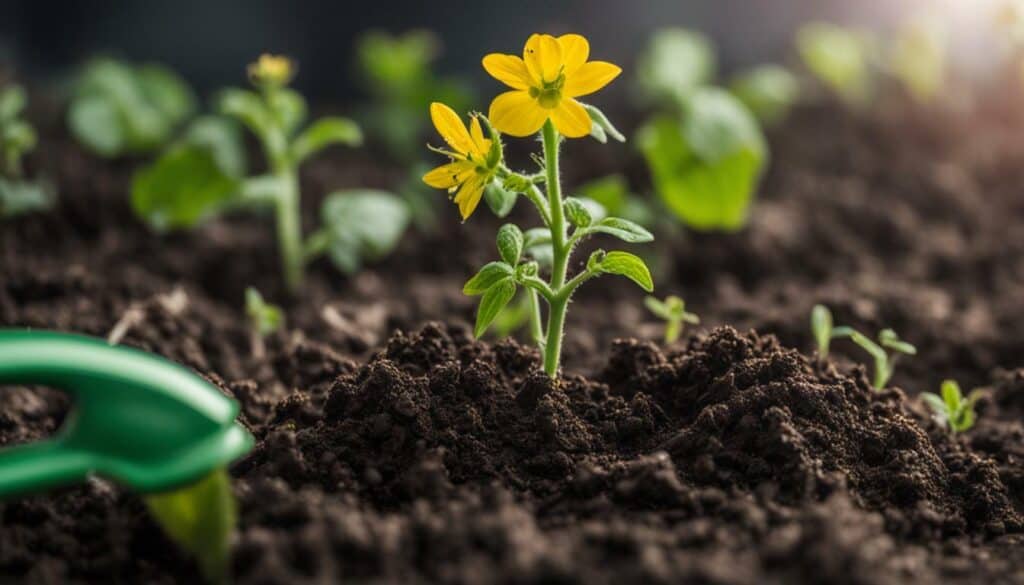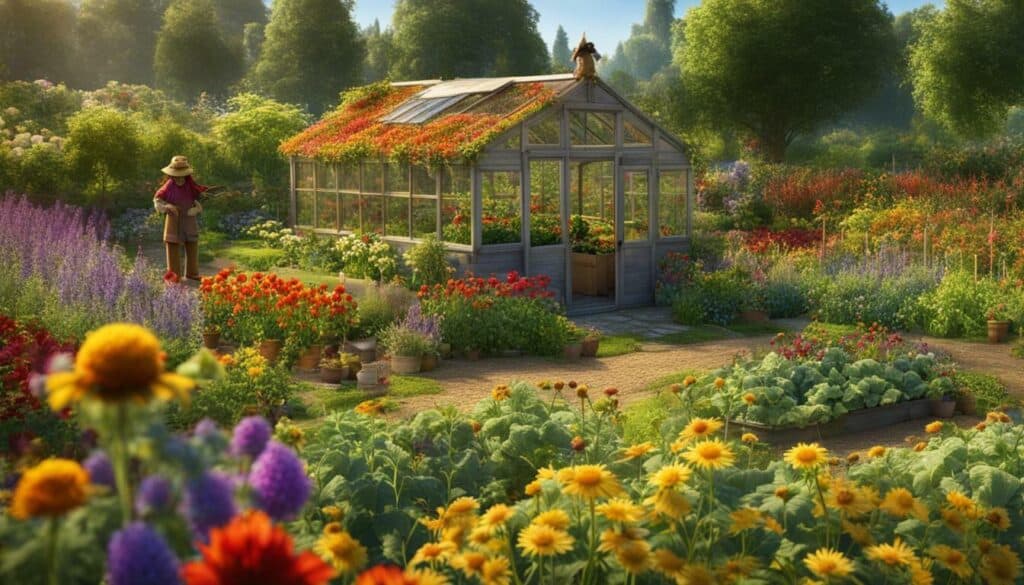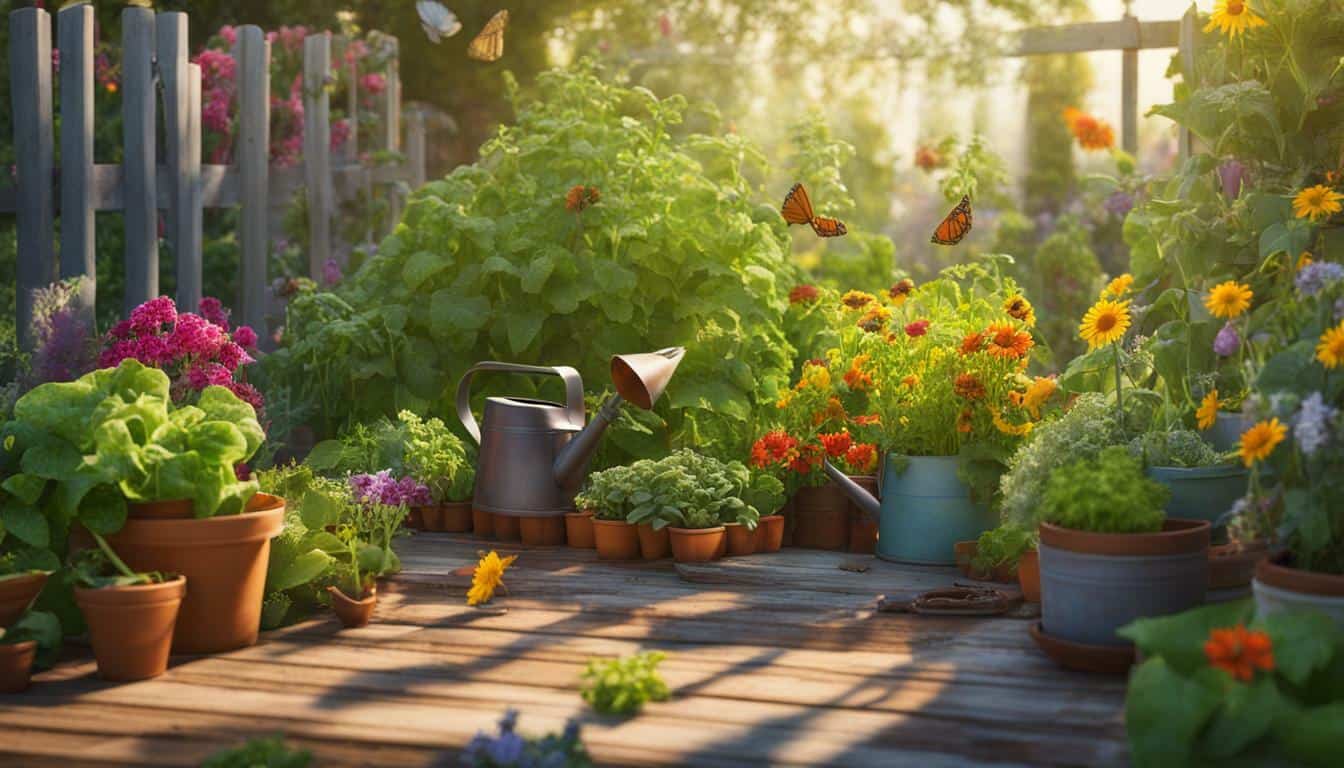Whether you’re a gardening novice or a seasoned expert, growing a home garden can bring immense joy and satisfaction. And with the right tips and tricks, you can create a thriving garden that yields plenty of fresh produce.
When starting a home garden, it’s important to choose the sunniest location in your yard and conduct a soil test to ensure your vegetables receive the necessary nutrients. Providing ample water and picking vegetables frequently can encourage more production. It’s also essential to use compost and be vigilant against insect damage to keep your garden healthy.
Tomatoes are a popular choice for home gardens. Different types, such as indeterminate and determinate varieties, have their own set of advantages. Starting with healthy plants, planting in full sun, and providing proper care through watering, fertilizing, staking, and pruning are essential steps for growing healthy tomato plants. Apart from tomatoes, there are many easy-to-grow vegetables for beginners like lettuce, green beans, radishes, zucchini, peppers, beets, carrots, chard, spinach, kale, and peas. It’s important to choose vegetables that you and your family enjoy eating and consider the availability of certain vegetables in your area. Additionally, it’s important to plant vegetables at the appropriate time based on their growing season.
Key Takeaways:
- Choosing the sunniest location is essential for a successful home garden.
- Get a soil test to ensure your vegetables receive the necessary nutrients.
- Provide ample water and pick vegetables frequently to encourage more production.
- Use compost and be vigilant against insect damage to keep your garden healthy.
- Starting with healthy plants, planting in full sun, and providing proper care is essential for growing healthy tomato plants.
- Choose easy-to-grow vegetables that you and your family enjoy eating and consider the availability of certain vegetables in your area.
- Plant vegetables at the appropriate time based on their growing season.
Vegetable Gardening Tips and Tricks
To ensure a successful vegetable garden, it’s crucial to follow key tips and tricks for growing healthy and abundant produce. Here are some specific techniques for vegetable gardening:
| Tip | Explanation |
|---|---|
| 1. Choose a sunny location | Most vegetables require at least 6-8 hours of direct sunlight per day. Select a site that gets plenty of sun to ensure optimal growth. |
| 2. Conduct a soil test | Get a soil test to determine the pH and nutrient content of your soil. Most vegetables prefer a pH of 6-6.5 and nutrient-rich, loamy soil. |
| 3. Water regularly | Aim to provide about 1 inch of water per week, whether through rainfall or irrigation. Consider installing a sprinkler system to ensure consistent watering. |
| 4. Plant tender vegetables after the last frost date | Wait until after the last frost date for your region to plant tender vegetables like peppers, eggplants, and tomatoes. Consult the USDA Hardiness map to find out when it’s safe to plant. |
| 5. Pick vegetables frequently | Harvest vegetables as soon as they are ripe to encourage more production. Harvesting vegetables with seeds in them stimulates the plant to produce more flowers and edible vegetables. |
| 6. Add compost to your garden | Compost is made from decomposing plant materials and provides nutrients and beneficial microorganisms to the soil. Add it regularly to keep your soil healthy and rich. |
| 7. Prevent and treat insect damage | Regularly check your plants for signs of pests and use natural methods to prevent and treat insect damage. Early detection can prevent infestations from spreading. |
| 8. Preserve excess produce | Consider learning home canning techniques or donating excess vegetables to local food pantries to prevent waste and share the bounty of your garden. |
| 9. Clean up your garden | At the end of the season, remove plant debris and dispose of it properly to prevent the spread of diseases. |
| 10. Grow what you love | Finally, focus on growing vegetables that you enjoy eating. Gardening should be a fun and enjoyable experience, so choose the vegetables that bring you the most joy. |
In addition to these tips and tricks, the article also includes information on growing tomatoes and starting a vegetable garden from scratch. By following these techniques and the advice provided in the rest of the article, you can create a thriving vegetable garden and enjoy delicious homegrown produce.
Growing Healthy Tomato Plants
Growing tomatoes is a popular starting point for many gardeners, and with the right techniques, you can ensure a bountiful harvest of juicy, homegrown tomatoes.
First, it’s important to choose the right location for your tomato patch. Tomatoes require at least 6 to 8 hours of direct sunlight per day and well-draining soil. When planting, make sure to start with healthy plants or quality seeds.
| Key Factors: | Techniques: |
|---|---|
| Planting: | Place tomatoes deeply to encourage strong root development. |
| Watering: | Water tomatoes thoroughly about once a week, providing them with roughly an inch of water. |
| Soil Nutrients: | Adding compost and fertilizer to the soil can provide necessary nutrients to your tomato plants. |
| Support: | Staking or supporting tomato plants is recommended, especially for indeterminate varieties. |
Pruning suckers between branches is also a technique you can use to increase fruit production. Finally, being vigilant about pests and diseases and addressing them early on is essential to keeping your tomato plants healthy and productive.

By following these tips, you can enjoy a bountiful harvest of delicious and healthy tomatoes from your very own vegetable garden. Happy planting!
Starting a Vegetable Garden from Scratch
If you’re new to gardening, starting a vegetable garden from scratch can be an exhilarating and fulfilling adventure. To ensure success, there are a few key considerations to keep in mind. First and foremost, you’ll need to choose a sunny location in your yard that gets at least six hours of direct sunlight each day.
Before you start planting, it’s a good idea to get a soil test done. This will help you determine the pH level of your soil and any necessary amendments needed to ensure optimal growth. Once your soil is ready, it’s important to water your garden regularly. In general, it’s best to water your garden daily or install a sprinkler system to make watering easier.
Another important factor to keep in mind is the planting schedule. It’s essential to wait until after the frost date to plant tender vegetables like tomatoes, cucumbers, and peppers. Regularly picking vegetables encourages more production while adding compost to the soil is beneficial for overall plant health.
One of the most important things to remember when starting a vegetable garden is vigilance. Insect damage can quickly derail a garden, so it’s important to keep an eye out for pests and treat them as soon as they appear. At the end of the season, it’s important to clean up the garden thoroughly to prevent pests and diseases from overwintering in the soil.
When it comes to selecting vegetables, it’s best to start small and choose easy-to-grow varieties that you and your family enjoy. Some great options for beginners include tomatoes, lettuce, zucchini, green beans, and herbs like basil and thyme. Be sure to also consider the timing of planting, as different vegetables have different planting times.
By following these tips and tricks, you’ll be on your way to creating a successful vegetable garden from scratch. So roll up your sleeves, grab your garden gloves, and get ready to enjoy the fruits of your labor!

Flower Gardening for Beauty and Joy
Flowers have a remarkable ability to bring beauty and joy to any home garden, creating vibrant displays of color and fragrance. Whether you’re looking to add a pop of color to your front yard or create a peaceful oasis in your backyard, there are endless possibilities when it comes to flower gardening.
When choosing flowers for your garden, consider the specific growing conditions of your space. Some flowers require full sun, while others thrive in partial shade. Take into account the amount of water and maintenance required, as well as your personal preferences for color and fragrance.
Once you’ve selected your flowers, it’s important to understand how to properly care for them. Regular watering, fertilizing, and deadheading (removing spent blooms) will help keep your flowers looking their best throughout the growing season.
One popular flower gardening technique is companion planting, which involves planting certain flowers and plants together to enhance growth and repel pests. For example, planting marigolds near vegetable plants can help keep pests at bay.
To create a visually pleasing garden, pay attention to the layout and placement of your flowers. Grouping similar colors and textures together can create a cohesive look, while planting taller flowers towards the back can create depth and interest.
Above all, flower gardening is about enjoying the process and the beauty it adds to your life. Take the time to appreciate your garden and the joy it brings to your home.

The Art of Container Gardening
Container gardening offers a versatile and convenient way to bring the joy of gardening to any space, whether you have a small balcony or a spacious backyard. This popular gardening technique allows individuals to grow their favorite vegetables and plants in small containers, making it especially beneficial for those who have limited space or live in urban areas.
One of the key tips to successful container gardening is choosing the right location with sufficient sunlight. Place your containers in a location where they will receive at least 6 to 8 hours of direct sunlight every day.
When selecting the appropriate vegetable varieties for container gardening, consider options such as cherry tomatoes, lettuce, peppers, and herbs. Begin small and gradually expand your container garden as you gain experience.
It is crucial to use high-quality soil and provide adequate drainage for the containers. You can also consider using a potting soil mix specifically designed for container gardening. Ensure that the containers have proper drainage holes to prevent waterlogging, which can damage roots and lead to plant death.
Regular maintenance is essential for healthy container plants. This includes regular watering, fertilizing, and monitoring for pests. Check the soil moisture frequently and water as needed to prevent drying out. Fertilize with an organic, slow-release fertilizer once a month to provide essential nutrients to the plants. Monitor for pests and treat promptly to prevent infestations.
With the proper care, container gardens can yield delicious and fresh vegetables, providing a rewarding and enjoyable gardening experience. Whether you’re growing vegetables, herbs, or flowers, container gardening can be a fun and practical way to create a beautiful and productive home garden.

Harvesting the Fruits of Your Labor
The moment of harvesting is undoubtedly one of the most rewarding experiences in a home garden, as you get to enjoy the literal fruits (and vegetables) of your labor. To ensure a successful harvest, follow these tips for vegetable gardening:
| Tip | Description |
|---|---|
| Choose a sunny location | Vegetables require at least six hours of sunlight per day to thrive. Choose a sunny location for your garden to ensure optimal growth. |
| Get a soil test | A soil test can determine the pH level of your soil and identify any nutrient deficiencies. Amend your soil as necessary to provide optimal growing conditions for your vegetables. |
| Provide adequate water | Vegetables require consistent moisture, especially during dry periods. Water your plants regularly to promote healthy growth. |
| Wait to plant tender vegetables | Frost-sensitive vegetables like tomatoes and peppers should be planted after the last frost date to avoid damage. |
| Pick vegetables frequently | Regularly picking vegetables encourages more production and prevents overripe or rotten vegetables from attracting pests. |
| Add compost | Adding compost to your soil can provide essential nutrients to your vegetables and improve soil structure. |
| Be vigilant for insect damage | Check your plants regularly for insect damage and use natural or organic pest control methods to keep insects at bay. |
| Preserve extra vegetables | If you have an abundance of vegetables, consider preserving them through canning or donating them to a local food bank or shelter. |
| Clean up the garden | At the end of the growing season, clean up your garden to prevent plant diseases and prepare for next year’s growing season. |
Growing tomatoes is a popular choice for many beginner gardeners. To ensure healthy tomato plants and a bountiful harvest, follow these tips:
- Choose between indeterminate and determinate tomato plants.
- Select the appropriate tomato variety for your growing conditions and preferences.
- Plant in full sun.
- Provide adequate water and use fertilizer as necessary.
- Support the plants with stakes or cages.
- Prune the suckers between branches for better fruit production.
- Be aware of common tomato plant diseases and treatments.
Starting a vegetable garden from scratch requires careful planning and consideration. Use these tips to get started:
- Choose a location with ample sunlight and well-draining soil.
- Start with a small garden size that you can manage.
- Select vegetables that you and your family enjoy eating.
- Consider the availability of vegetables at your local grocery store.
- Plant vegetables at the appropriate time based on their growing season.
- Arrange your vegetables in the garden based on their height and sun requirements.
- Regularly care for your plants throughout the growing season.
- Use high-quality seeds for better germination rates.

By following these gardening tips, organic gardening can provide a bountiful harvest of healthy, nutritious vegetables. Happy harvesting!
Cultivating an Organic Garden
For those seeking a more sustainable and eco-friendly approach to gardening, cultivating an organic garden can provide a fulfilling and healthier way to grow a wide variety of plants. To start, it is important to choose the sunniest location in your yard for the garden as most vegetables require ample sunlight. Conducting a soil test is crucial to determine the pH level and nutrient content of the soil. This will help determine what amendments, such as compost, need to be added.
Watering the plants daily and providing about an inch of water per week is necessary for their growth. It is crucial to wait until after the frost date to plant tender vegetables like tomatoes to avoid damage. Regularly picking vegetables encourages more production. Adding plenty of compost enriches the soil and provides necessary nutrients. Monitoring the plants for early signs of insect damage is essential to prevent infestations.

When it comes to growing tomatoes, it is recommended to start with healthy plants and provide sufficient sunlight, water, and fertilizer. Supporting the plants through staking or using cages helps them grow better. Pruning suckers between branches allows for more fruit production.
When starting a vegetable garden from scratch, choosing a suitable location with ample sunlight and good drainage is paramount. Starting small and selecting easy-to-grow vegetables is recommended for beginners. Creating a planting schedule and arranging the plants based on their growth requirements is also important.
Overall, cultivating an organic garden requires careful planning, regular maintenance, and attention to the needs of the plants. It is common to have excess vegetables, which can be preserved through home canning or given away to friends, family, or food pantries. Cleaning up the garden at the end of the season is important to prevent the spread of diseases.
Maintaining a Beautiful and Productive Garden
By implementing effective maintenance practices, you can ensure your home garden remains a flourishing oasis of beauty and productivity throughout the growing season. Here are some gardening techniques and tips that will help you keep your garden healthy and productive.
Choose a Sunny Location
Most vegetables require plenty of sunlight to grow and thrive. Therefore, it’s essential to choose the sunniest location in your yard to plant your vegetables. A location that receives at least six hours of full sun is ideal.
Conduct a Soil Test
A soil test will help you determine the pH level and nutrient content of the soil. Based on the results, you can make adjustments to the soil by adding organic matter, such as compost or manure, to improve soil fertility and drainage.
Water Regularly
Vegetables need a consistent supply of water to grow and produce. Therefore, it’s essential to water them regularly, especially during dry spells. Consider installing a drip irrigation system or setting up a sprinkler to provide your vegetables with an adequate amount of water.
Pick Vegetables Frequently
Regularly picking your vegetables encourages the plants to produce more. Harvest vegetables when they are ripe and ready, and don’t let them sit on the plant for too long. This will prevent them from becoming overripe and losing their flavor.
Add Compost
Adding compost to your soil enriches it with nutrients and improves overall plant health. Compost also helps retain moisture in the soil, reducing the need for frequent watering. Add a layer of compost to your garden bed each season to keep the soil fertile.
Protect Your Plants from Pests and Diseases
Be vigilant in identifying and preventing insect damage to your plants. Consider using natural pest control methods or organic pesticides to prevent damage to your crops. Remove any diseased plants from the garden to prevent the spread of disease.
Preserve Your Harvest
If you have excess vegetables, consider preserving them by canning, freezing, or dehydrating them for later use. You can also donate excess vegetables to local food banks or community gardens.
Clean Up at the End of the Season
Clean up your garden at the end of the season to prevent the spread of diseases. Clear out all plant debris and compost it or dispose of it as appropriate. Remove any stakes or supports you used during the growing season and store them for reuse.
Tomato Plant Maintenance
When it comes to growing tomatoes, they thrive in full sun and require warm weather to produce an abundant harvest. Choose between determinate and indeterminate tomato plants, and select the varieties based on your personal preferences. Provide adequate water, fertilizer, and support such as stakes or cages to help the plants grow. Pruning, thinning, and treating diseases are also essential for maintaining healthy tomato plants.
Starting a Vegetable Garden from Scratch
When starting a vegetable garden from scratch, select a suitable location with adequate sunlight, good drainage, and protection from strong winds. Start with a small garden and choose easy-to-grow vegetables that you and your family enjoy. Plan the arrangement of plants based on their growth habits and their preferred planting times. Lastly, take proper care of your garden by regularly watering, weeding, and protecting the plants from pests and diseases.
Overcoming Common Gardening Challenges
Every gardener faces their fair share of challenges, but with the right knowledge and strategies, you can overcome common obstacles and achieve gardening success. Here are some tips and tricks to help you grow great vegetables and avoid common mistakes.
Vegetable Gardening Tips and Tricks
Choosing a sunny location with well-draining soil is essential for successful vegetable gardening. A soil test can ensure that your soil is suitable for growing vegetables. Regular watering and waiting until after the frost date to plant tender vegetables are also important. Picking vegetables frequently encourages more production, and adding compost to the soil is crucial for enriching it. Be vigilant in catching and preventing insect damage. Properly cleaning up the garden at the end of the growing season can also help prevent plant diseases.
Growing Healthy Tomato Plants
Tomatoes are a popular vegetable to grow, but they can be challenging without the right techniques. Choosing the right variety of tomatoes, such as indeterminate or determinate, and selecting varieties like cherry tomatoes or beefsteak tomatoes based on your preferences is crucial. Ensuring that your tomatoes get plenty of sunlight and regular water, staking or providing support for your tomato plants, and pruning the suckers between branches to promote more fruit production are also important. Lastly, be aware of common tomato plant diseases and their treatments.
Starting a Vegetable Garden from Scratch
Starting a vegetable garden from scratch requires careful planning. Choosing a sunny spot with well-draining soil and starting small to avoid overwhelming yourself is crucial. Choosing vegetables that you and your family enjoy eating and are well-suited to your climate is also important. Consider the size of your garden and leave enough space between plants for easy access. Follow the planting guidelines based on the type of vegetables you choose and make sure to care for your plants throughout the growing season.
Remember to grow what you love and enjoy the process of gardening. By following these tips, you can overcome common gardening challenges and enjoy a successful vegetable garden.
Conclusion
Growing a home garden is a truly rewarding experience, providing not only fresh produce and beautiful flowers but also a sense of joy, accomplishment, and connection to nature. By following the gardening tips and techniques provided in this guide, anyone can create a beautiful and productive garden right in their own backyard.
Vegetable gardening is a great place to start, and with the right location, soil, and care, gardeners can grow a variety of delicious and nutritious vegetables. Regular watering, picking, and cleaning can help prevent plant diseases and promote healthy growth.
In particular, tomatoes are a popular and easy-to-grow vegetable for beginners. With the right planting techniques and care, homegrown tomatoes can offer unbeatable flavor and freshness.
When starting a new garden, it is important to start small and choose vegetables that you and your family enjoy. Proper location, timing, and care can help ensure a bountiful harvest and a beautiful garden.
Finally, organic gardening practices can enhance the health and productivity of your garden, using natural methods to promote soil health, pest control, and plant growth.
With these home garden ideas and gardening tips in mind, anyone can enjoy the many benefits of growing their own produce and flowers. So why not start your gardening journey today?
FAQ
Q: What are some vegetable gardening tips and tricks?
A: To unlock the joy of growing a home garden, you should choose the sunniest location, conduct a soil test, provide ample water, and pick vegetables frequently to encourage production. Composting and preventing insect damage are also important steps.
Q: How do I grow healthy tomato plants?
A: To grow healthy tomato plants, start with healthy plants, plant in full sun, wait until the weather is warm, provide adequate water and fertilizer, plant deeply, stake the plants, and prune as necessary.
Q: How do I start a vegetable garden from scratch?
A: To start a vegetable garden from scratch, pick the right location, choose an appropriate plot size, and select the right vegetables based on personal preference, availability, and care requirements. Plan the placement and timing of each vegetable.
What Are the Essential Steps for a Beginner to Start Growing Their First Garden?
Are you ready to embark on your gardening journey? Follow this beginner’s guide to growing your first garden. First, choose the right location with ample sunlight and good soil. Next, decide on the type of garden you want, be it a vegetable, herb, or flower garden. Prepare the soil by removing rocks and weeds, and then add compost and organic matter. Select plants suitable for your climate and start planting. Regular watering, weeding, and fertilizing are crucial for healthy growth. Lastly, stay patient and enjoy the process of cultivating your own little oasis.
Source Links
- https://homegardenjoy.com/site/2021/04/the-top-5-vegetable-garden-mistakes.html
- https://homegardenjoy.com/site/2015/07/growing-tomatoes.html
- https://www.almanac.com/vegetable-gardening-for-beginners
- https://growinginthegarden.com/gardening-for-beginners-how-to-start-a-garden-in-8-simple-steps/
- https://parkseed.com/indoor-gardening-beginner/a/indoor-gardening-beginner/
- https://savvygardening.com/6-things-every-new-vegetable-gardener-needs-to-know/
- https://youshouldgrow.com/vegetable-gardening-tips-for-beginners/
- https://savvygardening.com/tomato-garden/
- https://oldworldgardenfarms.com/2022/03/20/healthy-tomato-plants-2/
- https://ohioline.osu.edu/factsheet/HYG-1624
- https://www.bhg.com/gardening/vegetable/vegetables/planning-your-first-vegetable-garden/
- https://www.homedepot.com/c/ah/how-to-start-a-vegetable-garden/9ba683603be9fa5395fab90d6de2854
- https://www.creativevegetablegardener.com/flower-garden-design/
- https://greengardencottage.com/benefits-of-flower-gardening/
- https://growingupherbal.com/5-steps-beautiful-home-garden/
- https://extension.psu.edu/the-art-of-container-gardening
- https://www.amazon.com/Container-Gardening-Paul-Williams/dp/0756603722
- https://www.amazon.com/Art-Container-Gardening-Whiten/dp/0525483047
- https://www.sandiegouniontribune.com/lifestyle/home-and-garden/story/2020-07-11/garden-mastery-enjoy-the-fruits-and-the-vegetables-of-your-labor
- https://www.gardencityharvest.org/the-real-dirt-garden-city-harvest-blog/2015/08/05/enjoy-the-fruits-of-your-labor-harvesting-basics
- https://cottageatthecrossroads.com/enjoying-the-fruits-of-our-labor/
- https://bonnieplants.com/blogs/garden-fundamentals/organic-gardening-for-beginners
- https://www.bhg.com/gardening/vegetable/vegetables/tips-for-growing-an-organic-vegetable-garden/
- https://www.skh.com/thedirt/how-to-grow-an-organic-garden/
- https://oldworldgardenfarms.com/2020/06/21/vegetable-garden-healthy/
- https://www.theartofdoingstuff.com/20-simple-gardening-tips/
- https://www.ruralsprout.com/low-maintenance-garden-tips/
- https://joegardener.com/podcast/overcoming-common-gardening-challenges/
- https://farmfitliving.com/top-garden-challenges/
- https://mother-nature.ca/9-common-gardening-challenges-and-solutions/
- https://growingourown.wordpress.com/6-conclusion/
- https://www.ncbi.nlm.nih.gov/pmc/articles/PMC6600618/
- https://www.ncbi.nlm.nih.gov/pmc/articles/PMC6372235/





Leave a Reply